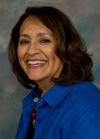Professor Montoya Takes the Lead in ABA Diversity Initiative
June 9, 2010

Professor Margaret Montoya was the lead scholar of a comprehensive American Bar Association initiative that analyzed a broad set of information aimed at advancing racial/ethnic, gender, disability and sexual orientation diversity within the legal profession. The result of the two-year effort, “Diversity in the Legal Profession: Next Steps,” a 68-page report, was released in April.
Information for the report was gathered during regional hearings held in Spring 2009, an online survey conducted January-June 2009, an invitational diversity summit held in June 2009 and a summit follow-up program held at the 2009 ABA Annual Meeting.
Citing 2009 census data, the report notes that Anglos make up about 70 percent of the workforce older than 16, but they represent 89 percent of all lawyers and 90 percent of all judges nationwide.
The report devotes most of its pages to specific recommendations for increasing diversity throughout the various sectors of the profession, with an overarching message that “a diverse legal profession is more just, productive and intelligent because diversity, both cognitive and cultural, often leads to better questions, analyses, solutions and processes.”
From working on the report, Cie Armstead, director of the American Bar Association’s Center for Racial and Ethnic Diversity, learned that diversity is a journey, not a destination. “Diversity must be an integral part of the standard operation of a legal organization. Diversity is here to stay and in this economic downturn, it’s important that the progress already made in diversity not be compromised.”
A key feature of the report is its inclusion of the voices and viewpoints of people from many sectors of the profession. The report emphasizes that diversity requires broad participation and creative partnerships.
In compiling and writing the report, Montoya worked with two young scholars, Tucker Culbertson, a law professor at Syracuse University; and Marc-Tizoc Gonzalez, a practitioner in Oakland, CA, to develop a fresh analysis and bring renewed energy to the task of bringing more under-represented group members into the legal profession.
“I can’t say enough about Margaret’s contribution to this project,” said Armstead. “This whole two-year process could not have had any measure of success without her involvement.
“Even though her primary work has an academic focus, Margaret has full appreciation of the various perspectives of diversity,” she added. “This was invaluable in that she could serve as a bridge between the academics and practitioners. As a result, we could look deep and wide at the issues.”
